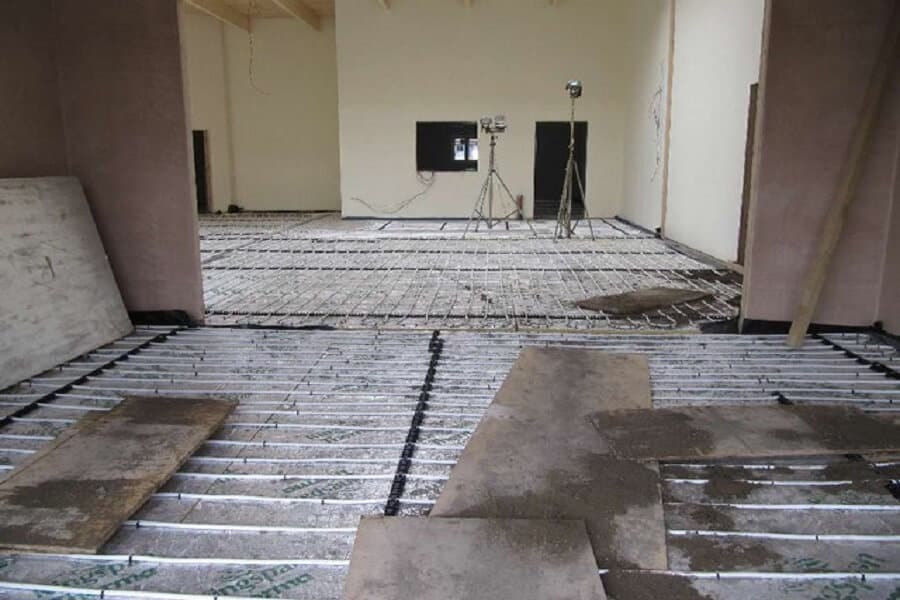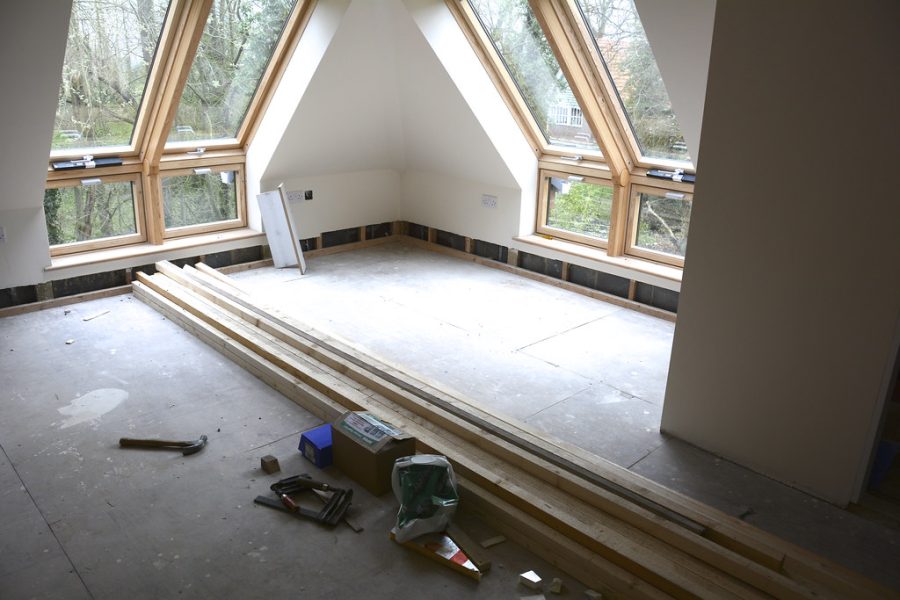Underfloor heating is no longer just a luxury for the main living spaces of homes or other building structures. As homeowners look to maximise every inch of their property, the loft has become a prime candidate for such enhancements. In this article, you will learn how to install underfloor heating in a loft conversion, transforming it from a mere storage space to a cosy and functional living area.
Key points:
- Find out why underfloor heating in lofts is a good idea.
- Note down the materials and tools needed for this project.
- Follow the intricate step by step guide for adding underfloor heating in lofts.
- Understand the benefits and best floor types for loft conversions with underfloor heating.
Materials and Tools Needed:
For this project, you will need the following (if undertaking the project yourself):
- Underfloor heating kit (electric or water-based)
- Insulation boards or overlay systems
- Self levelling compound (if needed)
- Digital multimeter or other heating controls (for electric systems)
- Pipe cutter (for water systems)
- Adhesive and levellers
- Scissors
- Trowel
Step by Step Guide: Install Underfloor Heating in a Loft
1. Preparation:
- Clear the Loft: Remove any furniture, items, or old flooring from the loft.
- Inspect the Subfloor: Ensure the subfloor is clean, dry, and free from any debris. If the floor is uneven, use a levelling compound to create a smooth surface.
2. Lay Insulation Boards:
- Start by laying insulation boards on the loft floor. This step is crucial as it prevents heat from escaping downwards and ensures maximum efficiency.
- Cut the boards to fit any corners or edges of the loft.
3. Plan the Heating Layout:
For electric systems, roll out the heating mats or cables, ensuring they’re evenly spaced and not overlapping.
For water systems, plan the route of the pipes, ensuring they’re evenly spaced.
4. Install the Heating System:
For Electric Systems:
- Use adhesive tape to secure them in place.
- Connect the heating wires to the thermostat, ensuring all connections are secure. Use a digital multimeter to check for any issues.
Water Systems:
- Lay out the pipes according to your planned layout.
- Connect the pipes to the underfloor heating manifold and ensure there are no leaks.
5. Test the System:
Before proceeding, it’s crucial to test the system.
- For electric systems, turn on the thermostat and ensure the floor starts warming up evenly.
- For water systems, run the system and check for any leaks or issues.
6. Cover the Heating System:
Once you’re sure the system is working correctly, cover it.
- For electric systems, you can lay a thin layer of self-levelling compound over the heating mats to protect them.
- For water systems, ensure the pipes are well-insulated and then cover them with your chosen flooring.
7. Install the Final Flooring:
- Depending on your choice (carpet, wood, vinyl, etc.), install the final flooring over the underfloor heating system.
- Ensure the flooring is compatible with underfloor heating.
- Some materials, like thick carpets, might insulate the heat, reducing efficiency.
8. Final Testing:
Once everything is installed, run a final test. Ensure the heat is distributed evenly across the loft and that there are no cold spots.
Benefits of Floor Heating in Attics

Transforming your loft with a floor heating system can elevate its comfort and functionality. Historically, lofts were merely storage spaces in older homes. However, the modern trend leans towards converting these spaces into master bedrooms, children’s play areas, or home offices.
With underfloor heating in a loft, you not only get a warm and inviting space but also enjoy the aesthetic freedom, devoid of unsightly pipes and radiators. Given the unique architectural challenges of a loft, such as reduced ceiling height and slanted roofs, a low-profile heating solution is essential to maintain adequate heat distribution.
Project Type
Loft Conversion:
Expanding your home’s footprint by converting the loft is a smart move. This not only adds value but also provides additional living space. When undertaking such a project, underfloor heating in a loft can seamlessly integrate without compromising the room’s height.
Loft in a New Build:
Planning a new home with a loft? Incorporate a wet underfloor heating system right from the design phase, ensuring it fits perfectly within your architectural blueprint.
Best Heating Systems for your Loft
Electric Systems: Electric underfloor heating systems are a boon for lofts. Their slim design ensures minimal impact on floor heights, crucial in spaces with potentially lower ceilings.
Water Systems: Don’t be daunted by the idea of a wet underfloor heating system for your loft. Whether it’s a new build or a conversion, we have a range of systems tailored for your needs.
Even if your loft has been designed with timber flooring, we have the ultimate article on how to install underfloor heating on timber floors too.
Suitable Subfloors and Floor Finishes

Historically, lofts in older homes often feature suspended timber subfloors. In contrast, modern homes might opt for concrete subfloors. Thankfully, most of our electric or water underfloor heating systems are compatible with both. When it comes to finishes:
- Carpet: A favourite for its warmth and comfort. But does underfloor heating work with carpets? Find out now.
- Wood: Both engineered and natural wood finishes complement lofts, especially those with exposed beams.
- Vinyl: A practical choice, easy to clean, ideal for playrooms or workspaces. Check out more by reading our essential guide on vinyl flooring for underfloor heating.
- Concrete: Although you are unlikely to have concrete flooring in your loft, it is still important to know how to install underfloor heating on concrete floors for any scenario.
Heat Loss in your Loft
Before diving into the installation of underfloor heating in a loft, ensure you’ve calculated the heat-loss for your loft. Proper insulation is paramount; without it, even the best heating system won’t function efficiently. Pair your heating system with Novatherm insulation and overlay systems to boost its energy efficiency. Interestingly, even without a loft conversion, heat can still escape from it, and therefore it is worthwhile to know about what causes heat loss in homes, as well as how to reduce heat loss in a house.
Maintaining Underfloor Heating in a Loft
Here are some additional tips that we believe you need to know when maintaining underfloor heating in your loft conversion.
Regular Maintenance: Underfloor heating in a loft, especially water-based ones, require periodic maintenance to ensure they function optimally. It’s advisable to:
- Check for any leaks or blockages in the pipes.
- For electric systems, ensure the wires and connections are intact.
- Clean the manifold and check the pressure in water systems.
Longevity and Warranty: A well-installed underfloor heating system can last for decades. Most manufacturers offer warranties ranging from 10 to 25 years. However, the actual lifespan can be much longer if the system is well-maintained.
Energy Efficiency and Cost Savings:
One of the significant advantages of underfloor heating in a loft is its energy efficiency. By distributing heat evenly across the room, it ensures:
- Reduced energy consumption.
- Lower heating bills in the long run.
- A smaller carbon footprint, making it an eco-friendly choice.
- Choosing the Right Thermostat
Importance of a Good Thermostat: A thermostat is the brain of your underfloor heating in a loft system. It regulates the temperature, ensuring the system runs efficiently.
Smart Thermostats: Modern thermostats can be controlled remotely using smartphone apps. They can learn your schedule and adjust the heating accordingly, saving energy.
Manual vs. Programmable: While manual thermostats allow you to set a constant temperature, programmable ones let you set different temperatures for different times of the day.
Safety Precautions
Insulation:
Ensure that the loft is well-insulated before commencing with your installation project for underfloor heating in a loft. This not only aids in the efficiency of the heating system but also ensures safety by preventing any potential overheating.
Electrical Safety:
If you’re installing an electric system, ensure that all connections are safely made. It’s advisable to hire a certified electrician to handle the electrical aspects of the installation.
Water System Precautions:
For water systems, ensure there’s a mechanism to release pressure if it builds up too much in the pipes. Also, ensure that the system has been purged of any air, which can cause blockages or inefficient heating.
Installation Tips and Best Practices
To ensure that your underfloor heating in a loft project can be handled safely when adding underfloor heating to it, make sure to consider these installation tips and practices:
- Professional Consultation: Always consult with a professional before starting the installation of underfloor heating in a loft. Their expertise can guide you in choosing the right system and ensuring it’s installed correctly.
- Safety First: Ensure all electrical connections are safely made, avoiding any potential hazards.
- Test Before Finalising: Before sealing everything up, test the system to ensure it’s working efficiently.
Follow our Flooring for Loft Conversion Tips
Incorporating underfloor heating in a loft can significantly enhance their comfort and utility. As we’ve explored, there are various systems, finishes, and considerations to keep in mind. But with the right approach, your loft heating can provide the warm, cosy, and efficient space you’ve always dreamed of. If you want to learn more about control temperatures in your loft, read more on keeping your loft warm and cold.
FAQs
Can I retrofit underfloor heating in a loft that is already finished?
Yes, you can retrofit underfloor heating in an already finished loft. However, it might require some modifications. For instance, you may need to lift the existing flooring to install the heating system and then relay the floor. Electric systems, especially heating mats, are often preferred for retrofitting due to their thin profiles, making the process less invasive. We offer more information in our guide on how to retrofit underfloor heating.
How long does it typically take to install underfloor heating in a loft?
The installation time varies based on the type of system and the size of the loft. For electric systems, it can take a day or two for an average-sized loft. Water-based systems might take longer, around 2-4 days, as they involve more complex pipework and connections. It’s essential to factor in additional time if floor levelling or other preparatory work is needed.
Is underfloor heating suitable for lofts with limited ceiling height?
Absolutely! One of the advantages of underfloor heating is its low profile. Especially electric systems, which are incredibly thin, are ideal for lofts with limited ceiling height. They ensure you don’t lose any significant height while still providing efficient heating.
How do I control the temperature of the underfloor heating in a loft?
The temperature of underfloor heating systems is typically controlled using thermostats. Modern systems often come with smart thermostats that allow for remote control via smartphone apps. These thermostats can be programmed to maintain specific temperatures at different times of the day, ensuring optimal comfort and energy efficiency.
Will underfloor heating restrict the type of flooring I can use in my loft?
Underfloor heating is compatible with a wide range of flooring options. However, some materials conduct heat better than others. While tiles, stone, and engineered wood are excellent conductors of heat, thick carpets or certain types of laminate might insulate the heat, making the system less efficient. It’s essential to consult with your supplier or installer to ensure your chosen flooring is compatible with underfloor heating.
Sources
Roof Windows 4 You (2022). How to Keep a Loft Room Cool and Warm. [online] Available at: https://www.roofwindows4you.co.uk/knowledge-hub/how-to-keep-loft-room-cool-and-warm/#:~:text=One%20of%20the%20best%20ways,the%20hot%20air%20to%20escape. [Accessed 24/08/23]
